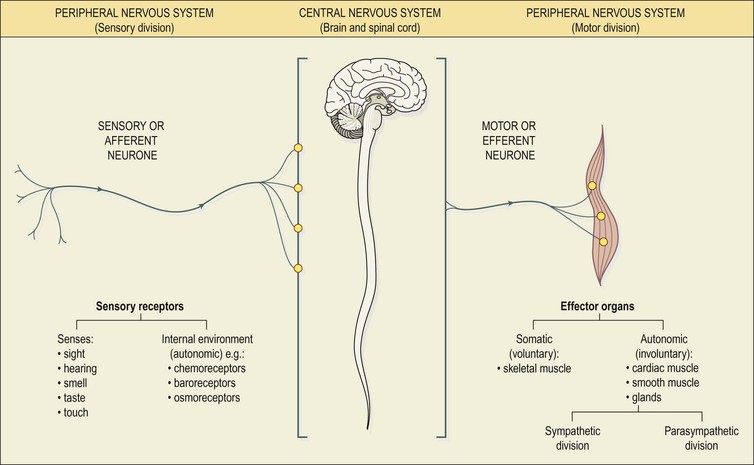
The preganglionic neuron is the first neuron in the pathway running from the spinal cord to the ganglion to synapse with the second neuron. In both divisions we have preganglionic and postganglionic neurons. The situation that we are in determines which division is most active (i.e. One causes heart rate to increase, whereas the other causes heart rate to decrease. Whichever is most active at a given time will determine the activity of the effector at that time. For example, the heart receives connections from both the sympathetic and parasympathetic divisions. Most target effectors receive dual innervation, meaning they receive innervation from both the parasympathetic and sympathetic divisions. This division is sometimes called the craniosacral division. Its pathways originate from the brainstem, traveling to effectors via cranial nerves, or from sacral levels S2-S4 in the spinal cord. The parasympathetic division is associated with rest and digest, conserving energy, replenishing energy stores, and conducting routine maintenance.Its pathways originate from the thoracic and first two lumbar levels of the spinal cord, and as a result, it is sometimes called the thoracolumbar division. It is active in situations of fear or rage, for example, and it is also active when we exercise. The sympathetic division is associated with the fight-or-flight response, preparing the body to respond to potentially dangerous situations.The two divisions of the autonomic nervous system are the sympathetic division and the parasympathetic division. In the autonomic nervous system, the axons are either lightly myelinated (meaning a thin layer of myelin) or unmyelinated, resulting in a slower conduction speed.ĭivisions of the Autonomic Nervous System In the somatic nervous system, the lower motor neuron axons are highly myelinated, allowing for a very rapid signal transmission from the spinal cord to the effector. The neurons that originate in the spinal cord begin in the lateral horn. The synapse between the two neurons occurs at a ganglion, or a collection of cell bodies.

In the autonomic nervous system there are two neurons in the pathway from the spinal cord to the effector organ. That lower motor neuron originates in the ventral (anterior) horn of the spinal cord. Since there is only one neuron, there is no synapse between neurons, and thus, no ganglia. The somatic nervous system has just one lower motor neuron traveling from the spinal cord to the effector muscle. There are a few key differences in the neurons and neuronal pathways between the somatic and autonomic nervous systems. That means it can cause muscle contraction or secretion from a gland, or it can prevent those actions from occurring. In the autonomic nervous system, stimulation can either excite or inhibit the effector. That means that, if the lower motor neuron is stimulated, it will cause the muscle to contract. You may remember from Unit 1 that lower motor neurons can only excite their effector. The autonomic nervous system controls involuntary contraction of cardiac and smooth muscle, as well as glandular tissue. This is the branch of the nervous system we were describing with the corticospinal tract and lower motor neurons in Unit 1. The somatic nervous system causes voluntary contraction of skeletal muscles (though contraction can happen without conscious awareness, like breathing). The nervous system can be divided into two functional parts: the somatic nervous system and the autonomic nervous system. Portions will be briefly reviewed in lecture. *This content will be covered in the assignment, primarily as self-study. *Covered only in lecture, not in this text Superior, middle, inferior cervical ganglion.Describe the effects of the parasympathetic and sympathetic divisions on organs and organ systems throughout the body.Describe the anatomy of the four pathways of the sympathetic division.Describe the sympathetic chain and the rami connecting it to the spinal nerve.Describe the anatomy of the parasympathetic divisions.




 0 kommentar(er)
0 kommentar(er)
